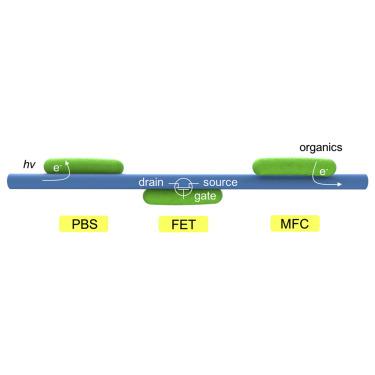Chem ( IF 19.1 ) Pub Date : 2018-07-12 , DOI: 10.1016/j.chempr.2018.04.004 Lin Xu , Yunlong Zhao , Kwadwo Asare Owusu , Zechao Zhuang , Qin Liu , Zhaoyang Wang , Zhaohuai Li , Liqiang Mai

|
The nano-bio interface generated by integrating semiconductor nanomaterials with living cells could serve as a platform for facilitating energy and signal transfer between non-living materials and living systems for applications in energy and the life sciences. This review presents recent advances in one-dimensional nanomaterial-biosystem interfaces and applications from chemical conversion and energy production to electrophysiology. First, we introduce representative types of nanowire-biosystem interfaces and their design principles. Second, we present nanomaterial-bacteria hybrids for solar-to-chemical CO2 reduction. Third, we introduce nano-bio hybrid electrodes for energy production, especially for biofuel cells. Fourth, we present semiconductor nanowire-embedded nanoelectronics interfaced with living cells and tissue for electrophysiological signal recordings. Last, we provide a brief summary of the progress on energy and signal transfer at the nano-bio interface, as well as our perspectives on the challenges and future directions in this interesting field.
中文翻译:

纳米线-生物系统界面的最新进展:从化学转化,能量生产到电生理
通过将半导体纳米材料与活细胞整合而产生的纳米生物界面可以用作促进能源和生命科学应用中非生命材料与生命系统之间能量和信号传递的平台。这篇综述介绍了一维纳米材料-生物系统界面的最新进展以及从化学转化和能量生产到电生理学的应用。首先,我们介绍纳米线-生物系统接口的代表性类型及其设计原理。其次,我们介绍了用于太阳能化学CO 2的纳米材料-细菌杂化体减少。第三,我们引入用于能量产生的纳米生物混合电极,尤其是用于生物燃料电池的电极。第四,我们提出了与活细胞和组织对接的半导体纳米线嵌入式纳米电子器件,用于电生理信号记录。最后,我们简要概述了纳米生物界面上能量和信号传输的进展,以及我们对这一有趣领域中的挑战和未来方向的看法。











































 京公网安备 11010802027423号
京公网安备 11010802027423号